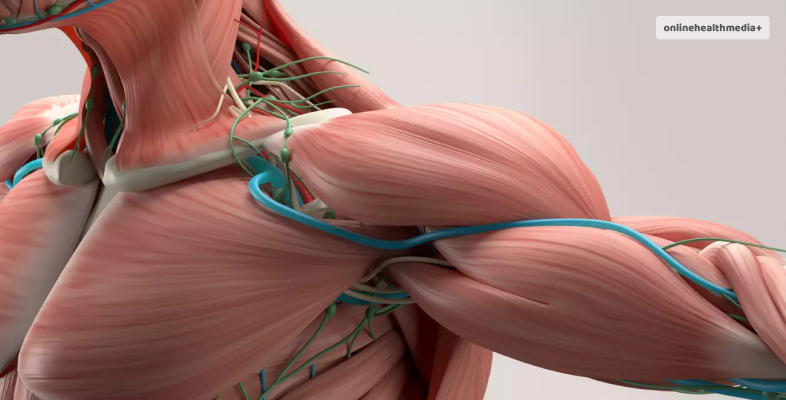Thoracic Outlet Syndrome (TOS): Everything You Need To Know About The Condition.
A group of conditions that result in the pressure on blood vessels in the area between the shoulders and the neck is recognized as thoracic outlet syndrome.
The space where this pressure builds is known as the thoracic outlet. The compression of the nerves and the blood vessels results in neck and shoulder pain.
Despite being a fairly rare disease that most of us haven’t even heard of- this condition affects at least 1-2% of the general population.
The condition often remains hidden due to the lack of symptoms in most people. The following article will describe the condition, diving into the definition, types, causes and symptoms. This will also include the treatment option.
Contents
What is Thoracic Outlet Syndrome?

As per a study in 2019, thoracic outlet syndrome is the group of different issues that present as a number of symptoms in the upper extremity and shoulder.
The identification of the condition is done through an extensive clinical examination that uses testing. The pathology of the condition is usually considered by the physicians such that any of the differential diagnosis is assessed.
The condition is detected in the area that is itself known as the thoracic outlet which is mainly under the compression. The compression may be due to a number of reasons such as pressure from any nearby organ or structure.
The pain is mainly due to the neurovascular structures that pass through this outlet- which is why the compression of nerves or the blood vessels cause pain and discomfort.
Let us dive into the classification of the condition.
Types of TOS

There are three types of TOS that are mainly classified on the basis of the symptoms and its pathophysiology. Following are the three groups:
- Neurogenic TOS or nTOS: The compression of the brachial plexus nerves causes nTOS.
- Venous TOS or vTOS: The compression of the axillary-subclavian vein causes vTOS.
- Arterial TOS or aTOS: The compression of the axillary-subclavian artery causes aTOS.
The classification of the types of TOS often links to the causes such as traumatic, congenital or functionally acquired.
Despite all three conditions causing neurovascular compression, their clinical presentation is quite different.
Neurogenic TOS is also often associated with traumatic TOS, disputed TOS, nonspecific TOS and true TOS. However, all of these terms have been dismissed by specialists of TOS.
What Causes TOS?

As said in the previous sections, the causes of this condition are mainly related to following three origins:
1. Congenital
The word congenital refers to the conditions that are present in an individual since birth. This can be seen as variations in the anatomy that is normally present- such that a person with TOS has an extra rib that fuses or is near the first rib. It may also happen that a person with TOS has a cervical rib. Other examples of this include the presence of abnormal neck muscles, ribs and ligaments that put pressure on the blood vessels or nerves that are present in the thoracic outlet.
2. Functional
These are a result of the actions that a person performs repeatedly which results in the condition. Additionally, the movement may be vigorous-which is what usually is observed in athletes. These arm movements may irritate the structures that are present in the thoracic outlet such that there is a serious injury.
3. Traumatic
These causes are mainly injuries that are often sudden in nature. For example, whiplash is a common cause of traumatic TOS. This also relates to the accidents that can result in these injuries to the thoracic outlet structures.
Symptoms of TOS

The symptoms are mainly signs that tell us when we are developing TOS. As the different types of TOS present themselves differently, there are chances you may not experience all the symptoms. The following points illustrate the symptoms of TOS:
- Tingling or pins and needles in your arm or near the clavicle
- Worsening pain, especially when you lift your arms
- Weakness
- Numbness
- Heaviness or swelling
- Changing color of the skin
- Skin that feels cool to the touch
- There are sores on your finger that heal slowly.
The type of TOS experienced by you depends on the nerve or blood vessels, similarly the cause of the condition can lead to different symptoms.
The brachial plexus is responsible for giving feeling and movement to the arms and hands. The tingling, numbing and pain which occurs is due to the compression on the brachial plexus.
Whereas, the subclavian vein is known to drain blood from the arms to the heart. Thus, the pressure on the subclavian vein results in heaviness and swelling.
The subclavian artery is responsible for supplying blood rich in oxygen to the arms. Thus, when you have a pressure on the subclavian artery, it leads to poor circulation resulting in tingling, pain, numbness and the skin feeling cool to touch.
Diagnosis

The diagnosis of the condition occurs through a primary physical exam that focuses on the upper limb tension test and the elevated arm stress test.
The physician can ask you to perform movements such as- lifting your arms, clenching your fist, and tilting your head.
Additionally, the lab and imaging tests are also ordered to confirm TOS, while also ruling out any of the other causes.
Following are the diagnostic tests that you may undergo to confirm TOS:
- Chest X-rays
- Blood tests
- EMG
- Computed Tomography
- MRI
- MRA
- Nerve conduction study
The imaging tests allow the physician to check for the causes such as abnormal anatomy as well as evaluate the flow of blood which can cause similar symptoms.
The nerve and muscle functions are also analyzed through these tests so that the underlying cause of the condition can be found. This helps in developing a treatment
Risk Factors
The following are the risk factors that elevate the risk of TOS:
- Repetitive injuries- mainly due to sports or job activities such as lifting
- Poor posture
- Tumors that press on the nerve
- Obesity
Treatment Options

The treatment options for the condition. Moreover, the diagnosis determines what type of TOS you have and the treatment that will be suitable. Following are the treatment options:
Physical Therapy– The common initial treatment option is physical therapy. This involves consultation from a physical therapist that can increase the range of motion. This strengthens the muscles and facilitates better posture. People with neurogenic TOS receive the highest benefit.
Medications- Over-the-counter medications such as pain relievers and NSAIDs are often what doctors prescribe for TOS. The other medications that are often added to the pharmacological therapy are thrombolytic medication. These help in breaking up the blood clots and preventing the formation of new ones. The prescription may also include anticoagulants.
Surgery- Surgery is an option for people with arterial TOS. Additionally, some people with neurogenic TOS may also need surgery when other treatment options have been ineffective. The type of TOS and the patient’s anatomy determines the surgery method. Consider this- a person with the underlying cause of TOS being an abnormal growth will receive decompression surgery. This will remove the structure that is increasing the pressure.
Prognosis

The prognosis is described to be excellent for patients with thoracic outlet syndrome, such that at least 90% of the cases resolve the symptoms with conservative therapy.
Moreover, these patients continue to experience no relapse unless the injury is related to repetitive movements. This requires lifestyle modifications that can improve the condition.
Prevention
The preventative measures for the condition include the following:
- Lowering the risk of injury from repetitive movement such as those for athletes can be through strengthening the muscles around the shoulder. If you are someone who is experiencing this type of TOS then you must consult your trainer or coach for the exercises that can help achieve that.
- Heavy lifting or overhead arm movements must be put on hold to lower the risk of an injury. The consultation with a healthcare provider helps in resolving the issue through exercises that lower the risk.
Support and Resources
The guidance of a healthcare provider ensures that the chances of developing TOS is reduced. However, the following recommendation are also useful:
- Working with a physical therapist
- Avoid putting heavy luggage on your shoulders and do not lift objects above your head.
- There are exercises that you can perform at home to improve your posture and strengthen your muscles.
- Modification of daily activities ensures that the risk of an injury is eliminated.
Questions To Ask Your Doctor:
These questions should help you receive an answer that is helpful for you:
- What is the type of thoracic output syndrome that I have?
- How did this happen?/ What is the cause?
- What is the treatment for me?
- Is there a specific timing I should maintain?
- Are there any risks associated with the treatments?
Wrapping It Up!
In conclusion, it can be said that the intensity of the pain that is associated with thoracic outlet syndrome is dependent on the causes.
The interference of the daily activities may feel frustrating as it slows you down.
Taking care of yourself through physical therapy or other treatment options, preventative steps can help in reducing the risk of further damage.
Consulting your healthcare provider is the best step to manage the condition instead of self-medication or self-treatment.
Also read
- The Best Topical Treatments For Flesh Wounds.
- Different Types Of Dementia: A Comprehensive Overview.
- 10 Things You Should Know About Having Dental Retainers.



